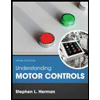
Understanding Motor Controls
4th Edition
ISBN: 9781337798686
Author: Stephen L. Herman
Publisher: Delmar Cengage Learning
expand_more
expand_more
format_list_bulleted
Concept explainers
Textbook Question
Chapter 42, Problem 6RQ
Refer to the circuit shown in Figure 42–17. Assume that the motor is running in the forward direction. When the revers e push button is pressed, the motor continues to run in the forward direction. Which of the following could cause this problem?
- a. The normally open side of the reverse push button is not making a complete circuit when pressed.
- b. R contactor coil is open.
- c. The normally closed side of the reverse push button is not breaking the circuit when the reverse push button is pressed.
- d. There is nothing wrong with the circuit. The stop push button must be pressed before the motor will stop running in the forward direction and permit the motor to be reversed.
Expert Solution & Answer
Want to see the full answer?
Check out a sample textbook solution
Students have asked these similar questions
In relation to the circuit presented below, mark the alternative(s) that you consider correct.
1 To enable actuator A2 to advance, it is necessary to switch valve V2 to the leftmost position and ensure that valve V1 is in its initial (intermediate) position.
2 Switching valve V2 to the leftmost position allows actuator A2 to advance, but for this to happen, valve V1 must also be switched to the leftmost position.
3 When activating valve V1, using the locking lever installed on the left side of it, the two actuators (A1 and A2) are allowed to advance.
4 Hydraulic pump B1 is a simple variable displacement type.
5 Valves V1 and V2 have a TANDEM center.
What happens when the low-voltage current flow in the coil primary winding is interrupted by the switching device?
The primary winding delivers a high-voltage spark to the plugs.
The magnetic field in the coil primary builds.
The secondary voltage drops to zero volts.
High voltage is induced in the secondary windin
5 position and 2-way type of ports DCV could be used in the double acting actuator circuit.
Select one:
True
False
Chapter 42 Solutions
Understanding Motor Controls
Ch. 42 - What are the three main electrical test...Ch. 42 - What is the advantage of a plunger type voltage...Ch. 42 - A motor is tripping out on overload. The motor...Ch. 42 - A motor is tripping out on overload. The motor...Ch. 42 - Prob. 5RQCh. 42 - Refer to the circuit shown in Figure 42–17. Assume...Ch. 42 - Prob. 7RQCh. 42 - Refer to the circuit shown in Figure 4221. Assume...Ch. 42 - Prob. 9RQCh. 42 - Refer to the circuit shown in Figure 42–21. Assume...
Knowledge Booster
Learn more about
Need a deep-dive on the concept behind this application? Look no further. Learn more about this topic, mechanical-engineering and related others by exploring similar questions and additional content below.Similar questions
- Refer to the circuit shown in Figure 97. Assume that when the forward push button is pressed the motor does not start, but when the reverse push button is pressed the motor will start in the reverse direction. When the stop button is pressed the motor stops running. Which of the following could NOT cause this problem? a. The forward push button is defective. b. The F starter coil is open. c. The overload auxiliary contact is open. d. The normally closed R contact is open.arrow_forwardRefer to the circuit shown in Figure 33–7. When the low speed push button is pressed, the motor begins to run in low speed. When the high speed push button is pressed, the motor stops running. Which of the following could cause this problem? The 1L contactor coil is open. H contactor coil is open. PR relay coil is open. The 2L contactor coil is open.arrow_forwardRefer to the circuit shown in Figure 16-11. Assume that the platform is located on the lower floor. When the UP push button is pressed, the platform rises. When the platform reaches the upper floor, however, the pump does not turn off but continues to run until the overload relay opens the overload contacts. Which of the following could cause this problem? a. The solenoid valve opened when limit switch LS1 opened. b. The UP push button is shorted. c. Limit switch LS1 did not open its contacts. d. Limit switch LS2 contacts did not reclose when the platform began to rise.arrow_forward
- To answer the following questions refer to the circuit shown in Figure 4110. Assume that the third speed push button is pressed and the motor starts in its first or lowest speed. After a delay of 3 seconds, the motor accelerates to its second speed, but never accelerates to its highest or third speed. Which of the following could cause this problem? a. CR coil is open. b. Coil 2TR is open. c. Coil 1TR is open. d. Coil 1S is open.arrow_forwardRefer to the circuit shown in Figure 107. Assume that when the start button is pressed the motor does not start, but when the inch push button is pressed the motor runs at reduced speed. Which of the following could NOT cause this problem? a. The control transformer fuse is blown. b. M starter coil is defective. c. The start push button is defective. d. The stop push button is defective.arrow_forwardRefer to the circuit shown in Figure 25–5. Assume that timer TR1 is set for a delay of 10 seconds and timer TR2 is set for a delay of 5 seconds. When the START button is pressed, the motor starts. After 10 seconds the S1 contacts open and the motor continues to accelerate, but never reaches full speed. After a delay of about 30 seconds, the motor trips out on overload. Which of the following could cause this problem? TR1 coil is open. S2 coil is open. S1 coil is open. R coil is open.arrow_forward
- Refer to the circuit shown in Figure 2614. When the START button is pressed, the control transformer fuse blows immediately. Which of the following could not cause this problem? a. Control relay coil CR is shorted. b. Starter coil 1M is shorted. c. Contactor coil S is shorted. d. Contactor coil 2M is shorted.arrow_forwardRefer to the circuit shown in Figure 16-11. Assume that the platform is located on the bottom floor. When the UP push button is pressed the pump motor does not start. Which of the following could not cause this problem? The contacts of limit switch LS1 are open. The contacts of limit switch LS2 are open. Motor starter coil M is open. The overload contact is open.arrow_forwardAn open winding in an electric motor means that A. the winding is making contact with the motor frame. B. one winding is making contact with another winding. C. a wire in one winding is broken. D. the centrifugal switch to the start winding is open.arrow_forward
- Assume that all three motors shown in Figure 12–14 are running. Now assume that the STOP button is pressed and motors #1 and #2 stop running, but motor #3 continues to operate. Which of the following could cause this problem? STOP button is shorted. The 2M contact between wire numbers 31 and 32 is hung closed. The 3M load contacts are welded shut. The normally open 3M contact between wire numbers 23 and 31 is hung closed.arrow_forwardTo answer the following questions refer to the circuit shown in Figure 41–10. Assume that the third speed push button is pressed. Explain the sequence of operation for the circuit.arrow_forwardRefer to the circuit shown in Figure 247. Assume that all timers are set for a delay of 5 seconds. When the START button is pressed the motor starts in its lowest speed. After a delay of over 10 seconds, the motor is still running in the lowest speed. Which of the following could cause the problem? a. TR1 coil is open. b. TR1 coil is shorted. c. S2 coil is open. d. S1 coil is shorted.arrow_forward
arrow_back_ios
SEE MORE QUESTIONS
arrow_forward_ios
Recommended textbooks for you
 Understanding Motor ControlsMechanical EngineeringISBN:9781337798686Author:Stephen L. HermanPublisher:Delmar Cengage Learning
Understanding Motor ControlsMechanical EngineeringISBN:9781337798686Author:Stephen L. HermanPublisher:Delmar Cengage Learning Understanding Motor ControlsMechanical EngineeringISBN:9781305498129Author:Stephen L. HermanPublisher:Cengage Learning
Understanding Motor ControlsMechanical EngineeringISBN:9781305498129Author:Stephen L. HermanPublisher:Cengage Learning Refrigeration and Air Conditioning Technology (Mi...Mechanical EngineeringISBN:9781305578296Author:John Tomczyk, Eugene Silberstein, Bill Whitman, Bill JohnsonPublisher:Cengage Learning
Refrigeration and Air Conditioning Technology (Mi...Mechanical EngineeringISBN:9781305578296Author:John Tomczyk, Eugene Silberstein, Bill Whitman, Bill JohnsonPublisher:Cengage Learning Automotive TechnologyMechanical EngineeringISBN:9781337794213Author:ERJAVEC, Jack.Publisher:Cengage,
Automotive TechnologyMechanical EngineeringISBN:9781337794213Author:ERJAVEC, Jack.Publisher:Cengage, Electrical Transformers and Rotating MachinesMechanical EngineeringISBN:9781305494817Author:Stephen L. HermanPublisher:Cengage Learning
Electrical Transformers and Rotating MachinesMechanical EngineeringISBN:9781305494817Author:Stephen L. HermanPublisher:Cengage Learning

Understanding Motor Controls
Mechanical Engineering
ISBN:9781337798686
Author:Stephen L. Herman
Publisher:Delmar Cengage Learning

Understanding Motor Controls
Mechanical Engineering
ISBN:9781305498129
Author:Stephen L. Herman
Publisher:Cengage Learning

Refrigeration and Air Conditioning Technology (Mi...
Mechanical Engineering
ISBN:9781305578296
Author:John Tomczyk, Eugene Silberstein, Bill Whitman, Bill Johnson
Publisher:Cengage Learning

Automotive Technology
Mechanical Engineering
ISBN:9781337794213
Author:ERJAVEC, Jack.
Publisher:Cengage,

Electrical Transformers and Rotating Machines
Mechanical Engineering
ISBN:9781305494817
Author:Stephen L. Herman
Publisher:Cengage Learning
Mechanical Design (Machine Design) Clutches, Brakes and Flywheels Intro (S20 ME470 Class 15); Author: Professor Ted Diehl;https://www.youtube.com/watch?v=eMvbePrsT34;License: Standard Youtube License